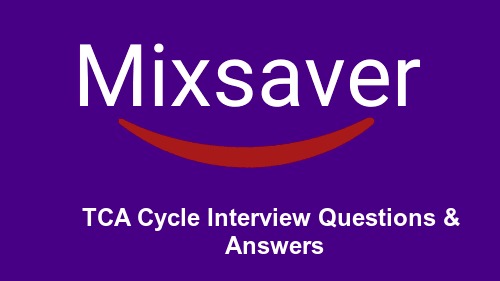1. How many molecules of ATPs are synthesized per NADH oxidation?
A. 1
B. 2
C. 3
D. 4
Answer: C
2. Why is the TCA cycle the central pathway of metabolism of the cell?
A. It occurs in the center of the cell
B. Its intermediates are commonly used by other metabolic reactions
C. All other metabolic pathways depend upon it
D. None of the above
Answer: B
3. In what form does the product of glycolysis enter the TCA cycle?
A. AcetylCoA
B. Pyruvate
C. NADH
D. Glucose
Answer: A
4. Malate-asparatate shuttle operates in
A. lungs and liver
B. heart and liver
C. pancreas and liver
D. none of these
Answer: B
5. Oxidation of a molecule involves
A. gain of electron
B. loss of electron
C. gain of proton
D. loss of proton
Answer: B
6. During cellular respiration, most of the ATP made, is generated by
A. oxidative phosphorylation
B. photophosphorylation
C. glycolysis
D. substrate-level phosphorylation
Answer: A
7. Important function of cholesterol is to
A. modulate fluidity
B. enhance blood circulation
C. prevent bile salts formation
D. None of these
Answer: B
8. To stop ATP synthesis which chemical is generally used?
A. DNSA
B. 2,4 dinitrophenol
C. DDT
D. None of the chemical can stop ATP synthesis
Answer: B
9. The enzymes of the TCA cycle in a eukaryotic cell are located in the
A. nucleus
B. mitochondria
C. plasma membrane
D. lysosomal bodies
Answer: B
10. Citric acid cycle occurs in
A. cytoplasm
B. mitochondria
C. endoplasmic reticulum
D. golgi bodies
Answer: B
11. Most multi-cellular organisms obtain energy for the synthesis of ATP during oxidative phosphorylation from
A. high energy phosphate compounds
B. a proton gradient across the inner mitochondrial membrane
C. a proton gradient across the cell membrane
D. a proton gradient across the outer mitochondrial membrane
Answer: B
12. Standard redox potential for a substance is measured under standard condition and is expressed as
A. mili-Ampere
B. Volt
C. without unit
D. Ohm
Answer: B
13. Most of the enzymes of the citric acid cycle in a eukaryotic cell are located in the
A. inner mitochondrial membrane
B. cytosol
C. mitochondrial matrix
D. intermembrane space
Answer: C
14. A positive redox potential means substance has
A. lower affinity for electron
B. higher affinity for electron
C. lower affinity for proton
D. higher affinity for proton
Answer: B
15. The end product of glycolysis is pyruvate, which enters the citric acid cycle after being converted to
A. acetic acid
B. acetyl-CoA
C. acetaldehyde
D. none of these
Answer: B
16. Energy that is released from glucose during respiration but not transferred to ATP bonds can be detected as
A. CO2
B. AMP
C. ADP
D. heat
Answer: D
17. Which of the following is involved in energy production?
A. Generation of proton gradients across membranes
B. Transport of electrons on organic molecules
C. Conversion of compounds with high energy to those of low energy
D. All of the above
Answer: D
18. Which of the following enzyme does not take part in the TCA cycle?
A. Citrate synthase
B. Iso-citrate dehydrogenase
C. Pyruvate dehydrogenase
D. Malate dehydrogenase
Answer: C
19. The first intermediate in TCA cycle is
A. succinate
B. fumerate
C. citrate
D. malate
Answer: C
20. Cholesterol can be synthesized de novo in
A. pancreas
B. intestine
C. liver
D. cell membrane
Answer: C
21. Which one of the following is not the intermediate of Kreb’s cycle?
A. Isocitrate
B. Succinate
C. Fumarate
D. Stearate
Answer: D
22. Which one is not the main protein in electron transport chain?
A. NADH dehydrogenase
B. Cytochrome bc1 complex
C. Cytochrome oxidase
D. Citrate synthease
Answer: D
23. How many ATPs are produced during citric acid cycle?
A. 10
B. 13
C. 12
D. 8
Answer: C
24. The FADH2 and NADH produced by the oxidation of one acetyl-CoA results in the synthesis of about-
A. 3 ATPs
B. 6 ATPs
C. 11 ATPs
D. 15 ATPs
Answer: C
25. In eukaryotes, electron transport occurs in
A. membranes and mitochondria
B. endoplasmic reticulum
C. cytoplasm
D. all of the above
Answer: A
26. The catabolism of sugars and fatty acids is similar because
A. both of these compounds are funnelled through the TC A/citric acid cycle
B. both of these compounds generate redox energy during catabolism
C. both of these compounds generate chemical energy during catabolism
D. all of the above
Answer: A





